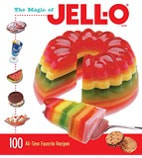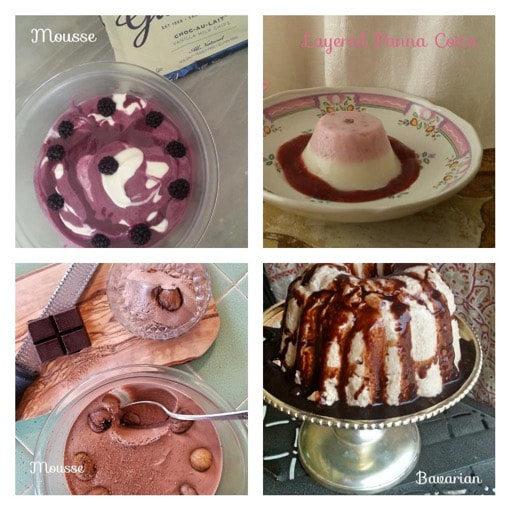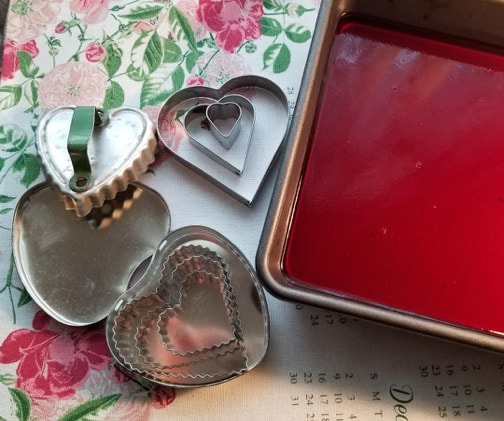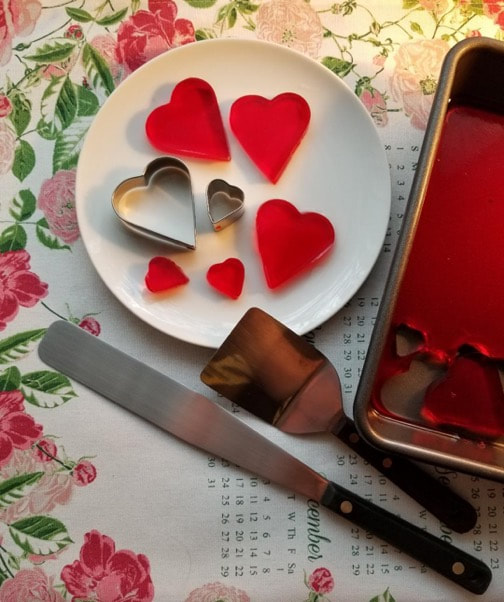Two of my favorite old-fashioned things: Valentine’s Day and stuff made with gelatin. To me, the possibilities and properties of gelatin are endlessly fascinating. Before Jell-O, there was sheet gelatin and before that, there was a calf’s foot. You see poor Julie Powell trying to make aspic (savory gelatin) in her tiny kitchen with a big-as-life calf’s foot while cooking her way through Julia Child’s Mastering the Art of French Cooking, in the movie Julie and Julia. Ugh, and aren’t you happy I did not put in a photograph of that?
Most of us are more familiar with Jell-O and unflavored gelatin powder made by Knox, as in “Knox Blox” or “finger gelatin.” I’m not sure how many of us of a certain age got through the public education system without consuming or making some Knox Blox. Or for better or worse, being confronted with a relative’s Jell-O mold, most likely a “salad” of bright green or red. My beloved Grandmother, Betty, made a fantastic red Jell-O, cottage cheese, and walnut mold that I still miss to this day. My friend Peggy’s mother, Pat, made an artery-clogging layered green and cream colored mold that featured multiple blocks of cream cheese and is so good, it makes you almost swoon.
Gelatin goes in and out of style. When it’s out, there are naysayers among us. However, a good 75% of the self-described Jell-O haters will turn toward the light if they can be conned into just tasting some. My own father objects to Jell-O as salad but will almost happily eat it for dessert, especially in the form of a mousse or charlotte or Bavarian or fluffy pie. To help us with the distinctions and differences of these types of gelled desserts, we have some definitions from Knox:
Clear or Simple Gel
A clear or simple gel is a basic juice or broth mixture. Solids may be added after the mixture has chilled to "the consistency of unbeaten egg whites".
Whip
A whip is a clear gel that has been chilled until partially set; and then beaten until fluffy. Solids are not added to whips.
Snow
A snow is a clear gel that has been chilled until partially set; unbeaten egg whites are added, and the mixture is beaten until stiff. Solids are not added to snows. This dish is also sometimes called a "sponge".
Mousse
A mousse is a clear gel that has been chilled until the "mixture mounds slightly when dropped from spoon". Whipped cream is then folded in; solids may also be folded in at this time.
Custard Gel
A custard gel contains egg yolks, milk and gelatine cooked to form a custard base.
Chiffon
A chiffon is a custard gel that has been chilled until "mixture mounds slightly when dropped from spoon". Stiffly beaten egg whites are then folded in; solids may also be folded in at this time.
Bavarian
A Bavarian is a chiffon with the addition of whipped cream.
Soufflé
A soufflé is a mousse, chiffon or Bavarian mixture chilled in a soufflé dish with a collar.
Charlotte
A charlotte is a mousse, chiffon or Bavarian mixture chilled in a bowl, loaf pan, or springform pan lined with ladyfingers.
Blend 'N Gel
A blend 'n gel is a clear or custard gel prepared in a blender or food processor. Generally, ice or another frozen food is added to speed the gelatine process.
What is missing from this chart is panna cotta. It translates from Italian as “cooked cream” but is actually a nontransparent gel where milk and or cream replace the water, fruit juice or broth.
The whole Knox info page can be found here: Knox basics
For Valentine’s Day, I chose graphically-clean jarred vanilla panna cotta punctuated with red gelatin hearts. Suzi and I made them last year and took the photo at the very top of the blog. They were a hit, so I kept them in the back of my mind to write about later. It’s always a bad idea for me to try to remember something I’ve done yesterday (five minutes ago?) let alone something from a year ago. Thus, here is the doubly freshly-tested recipe for Individual Panna Cottas with Red Gelatin Hearts with step-by-step photos of the procedure. You might want to begin a day or two before you plan to serve them. Liquids set with gelatin become firmer over time. For the vanilla panna cotta mixture, use the higher amount of gelatin if you are going to serve it right away or use just one packet is you plan to serve them in a few days. Or use just one packet if you like a very soft set. As the recipe is not unmolded, a soft set won’t harm anything and adds to the lusciousness of the texture.
Individual Panna Cottas with Red Gelatin Hearts
Makes 8 servings
Special equipment for red hearts: mixing bowl, heat-proof silicone scraper or wooden spoon, 8x8 pan, 1 ½” or 2” heart-shaped cookie cutter, small knife, small tray or baking sheet, kitchen towel
Special equipment for panna cotta: microwave-safe 2 quart bowl or batter bowl, heat-proof silicone scraper or wooden spoon, whisk, large mixing bowl, 8 1-cup canning jars or similar glass vessels
Red gelatin hearts:
- 1 cup cold water
- 1 packet (0.25 ounces) unflavored gelatin such as Knox@ brand
- 1 cup boiling water
- 1 large box (6 ounce) any flavor red gelatin (I like raspberry)
- Place 1 cup cold water in mixing bowl. Sprinkle unflavored gelatin over water and let soften for about 5 minutes.
- Add 1 cup boiling water. Using silicone spatula or wooden spoon, stir in red gelatin. Continue stirring until all gelatin is dissolved, about 3 to 4 minutes.
- Pour into 8x8 pan. Refrigerate 3 hours or up to two days in advance. Cover with plastic wrap for longer storage.
- When ready to assemble, remove red gelatin from refrigerator. Using small cookie cutter, carefully cut into heart shapes. If necessary, trim edges with small knife. Place one gelatin heart inside jar, near the bottom. Smooth out any air bubbles between glass and gelatin. Repeat with the rest of the jars. Set prepared jars on their sides, heart side down, on a kitchen towel-lined small tray and return to refrigerator while preparing panna cotta.
- 2 cups whole milk, divided
- 1 or 1 ½ packets (0.25 ounces each) unflavored gelatin (use 1 packet for a softer set)
- 2 cups heavy cream
- 1 cup sugar
- 1 tablespoon vanilla extract or vanilla bean paste
- 2 cups sour cream or Greek yogurt
- Optional garnish:
- Whipped cream
- Fresh raspberries
- In microwave-safe bowl, sprinkle unflavored gelatin over 1 cup milk and let soften for about 5 minutes. Microwave for 1 minute and stir until gelatin is dissolved. Microwave for an additional 30 seconds, if needed.
- Add 1 cup milk, cream, sugar, and vanilla. Microwave for 2 minutes, stir, microwave for 1 minute and stir until sugar is dissolved. Microwave for 1 additional minute, if needed, until sugar is completely dissolved. Cool 5 minutes.
- Whisk in sour cream. Whisk until smooth.
- Prepare ice bath in large mixing bowl. Set panna cotta bowl in ice bath, stirring occasionally, for about 15 to 20 minutes, until mixture is chilled. Do not allow mixture to set.
- Remove tray of prepared jars. Check to make sure hearts are still attached to sides of jars with no air bubbles. Working with one jar at a time, carefully fill with panna cotta mixture just until it covers the heart. Repeat with remaining jars.
- Chill until set, about 2 hours. Serve with whipped cream and/or a few raspberries. If making ahead, cover jars with lids. Serve within two days.
Any leftover red gelatin can be cut into squares and served as is or you can get creative with it. It can be returned to its liquid state with a brief trip to the microwave. Cut it into smallish squares and microwave on high for 10 to 20 seconds, stirring to dissolve. Let cool a few minutes then whisk in vanilla Greek yogurt until it turns a pleasing pink color. You can chill in individual jars just like that or pour your pink goo over small squares of the red gelatin in a jar.













 RSS Feed
RSS Feed